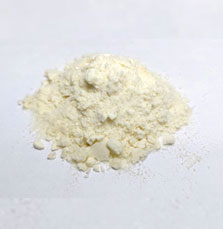ผลของพีเอชต่อกิจกรรมเอนไซม์โปรติเอสในสับปะรดผง ที่ผลิตจากกระบวนการทำแห้งเยือกแข็ง
คำสำคัญ:
โบรมิเลน, เอนไซม์, การทำแห้งเยือกแข็ง, สับปะรด, โปรติเอสบทคัดย่อ
สับปะรดมีเอนไซม์โปรติเอสชนิดหนึ่งผสมอยู่ชื่อเอนไซม์โบรมิเลน มีการผลิตเอนไซม์โบรมิเลนและนำไปประยุกต์ใช้อย่างกว้างขวางในอุตสาหกรรมอาหาร เครื่องสำอาง และยา กิจกรรมเอนไซม์และเสถียรภาพของเอนไซม์ โปรติเอสขึ้นอยู่กับปัจจัยหลายอย่างรวมไปถึงค่า pH งานวิจัยนี้มีวัตถุประสงค์เพื่อศึกษาผลของ pH ต่อคุณสมบัติทางกายภาพของสับปะรดผง และค่ากิจกรรมของเอนไซม์โปรติเอสในผลิตภัณฑ์สับปะรดผงที่ผลิตจากกระบวนการทำแห้งเยือกแข็ง ทำการผลิตสับปะรดผงด้วยสารละลายนอร์มอลซาไลน์โซลูชัน (NSS) และสารละลายบัฟเฟอร์ วิเคราะห์เปรียบเทียบคุณสมบัติทางกายภาพของสับปะรดผงด้านปริมาณน้ำอิสระ (aw) ปริมาณความชื้น ค่ากิจกรรมและเสถียรภาพของเอนไซม์โปรติเอสในช่วงเวลา 120 วัน ผลการทดลองพบว่าสารละลายโซเดียมฟอสเฟตบัฟเฟอร์ความเข้มข้น 40 มิลลิโมลาร์ สามารถปรับค่า pH ของน้ำสับปะรดจากกรดอ่อนให้เปลี่ยนเป็นกลางและเบสอ่อนได้ดี สับปะรดผงที่ผลิตจากสารละลาย NSS มีค่า aw สูง โดยมีค่าเท่ากับ 0.57 และมีปริมาณความชื้นสูงโดยมีค่าเท่ากับร้อยละ 11 ส่วนกิจกรรมของเอนไซม์โปรติเอสในสับปะรดผงที่ผลิตจาก NSS เสื่อมประสิทธิภาพอย่างรวดเร็ว โดยในวันที่ 120 มีค่ากิจกรรมเอนไซม์โปรติเอสเหลือร้อยละ 36.65 สับปะรดผงที่ผลิตจากสารละลายบัฟเฟอร์ pH 6.5, 7.0 และ 7.5 มีค่า aw เท่ากับ 0.4, 0.3 และ 0.3 ตามลำดับ และมีปริมาณความชื้นร้อยละ 8 โดยสับปะรดผงที่ผลิตจากบัฟเฟอร์ทั้งสามชนิดมี aw และปริมาณความชื้นต่ำกว่าของสับปะรดที่ผลิตจาก NSS จึงส่งผลกระทบให้กิจกรรมของเอนไซม์โปรติเอสมีเสถียรภาพที่ดีเป็นเวลานาน 120 วัน โดยมีค่ากิจกรรมเอนไซม์โปรติเอสมากกว่าร้อยละ 80 เมื่อสิ้นสุดการทดลอง
เอกสารอ้างอิง
กระทรวงสาธารณสุข. 2563. กำหนดหลักเกณฑ์ เงื่อนไข วิธีการใช้ และอัตราส่วนของวัตถุเจือปนอาหาร (ฉบับที่2). ประกาศกระทรวงสาธารณสุข. ราชกิจจานุเบกษา. 657 หน้า.
Azarkan, M., E. Maquoi, F. Delbrassine, R. Herman, N. M’Rabet, R.C. Esposito, P. Charlier and F. Kerff. 2020. Structures of the free and inhibitors-bound forms of bromelain and ananain from Ananas comosus stem and in vitro study of their cytotoxicity. Scientific Reports 10(1): 19570, doi: 10.1038/s41598-020-76172-5.
Bhatta, S., T.S. Janezic and C. Ratti. 2020. Freeze-drying of plant-based foods. Foods 9(1): 87, doi: 10.3390/foods9010087.
Chakraborty, N., R. Chakraborty and A. Saha. 2020. Fortified and freeze-dried kiwi fruit (Actinidia deliciosa): quality and sensory assessment. Brazilian Journal of Food Technology 23, doi: 10.1590/1981-6723.07719.
Erez, E., D. Fass and E. Bibi. 2009. How intramembrane proteases bury hydrolytic reactions in the membrane. Nature 459(7245): 371-378.
Ferreira, J.F., J.C.C. Santana and E.B. Tambourgi. 2011. The effect of pH on bromelain partition from Ananas comosus by PEG4000/phosphate ATPS. Brazilian Archives of Biology and Technology 54(1): 125-132.
Kaur, T., A. Kaur and R.K. Grewal. 2015. Kinetics studies with fruit bromelain (Ananas comosus) in the presence of cysteine and divalent ions. Journal of Food Science and Technology 52(9): 5954-5960,
Kritis, P., L. Karampela, S. Kokoris and M. Dalamaga. 2020. The combination of bromelain and curcumin as an immune-boosting nutraceutical in the prevention of severe COVID-19. Metabolism Open 8: 100066, doi: 10.1016/j.metop.2020.100066.
Liliana, S-C., PV-M. Diana and A.A. Alfredo. 2015. Structural, physical, functional and nutraceutical changes of freeze-dried fruit. African Journal of Biotechnology 14(6): 442-50.
Manzoor, Z., A. Nawaz., H. Mukhtar and I. Haq. 2016. Bromelain: methods of extraction, purification and therapeutic applications. Brazilian Archives of Biology and Technology 59: 1-16.
Rowan, A.D., D.J. Buttle and A.J. Barrett. 1988. Ananain: a novel cysteine proteinase found in pineapple stem. Archives of Biochemistry and Biophysics 267(1): 262-270.
Shofian, N.M., A.A. Hamid, A. Osman, N. Saari, F. Anwar, M.S. Dek and R.H. Hairuddin. 2011. Effect of freeze-drying on the antioxidant compounds and antioxidant activity of selected tropical fruits. International Journal of Molecular Science 12(7): 4678-4692.
Silva-Espinoza, M.A., C. Ayed, T. Foster, M.D.M. Camacho and N. Martinez-Navarrete. 2019. The impact of freeze-drying conditions on the physico-chemical properties and bioactive compounds of a freeze-dried orange puree. Foods 9(1): 32, doi: 10.3390/foods9010032.
Song, H. N., S.A., Ji, H.R. Park, H.H. Kim and C. Hogstrand. 2018. Impact of various factors on color stability of fresh blueberry juice during storage. Preventive Nutrition and Food Science 23(1): 46–51.






